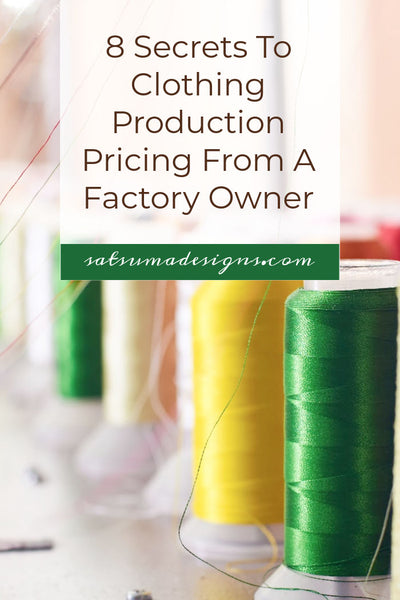How To Set S.M.A.R.T. Goals for a Fashion Brand
How To Set S.M.A.R.T. Goals for a Fashion Brand
Please note: Some links in this post may include Amazon and other affiliate links, which means I receive a commission if you make a purchase. Thank you!
SMART goals is an acronym for objectives that are specific, measurable, achievable, relevant, and time-bound.
The new year is a great time to set personal and business goals. This framework for fashion entrepreneurs outlines the types of goals to set at any time of year.
All business owners know that their creativity, drive and opportunity don't follow the calendar, so use these at any time to get thoughts and dreams to paper and take action.
Here is the method to set SMART goals for any size fashion brand, which will create a framework to execute growth strategies.
Set Specific Goals For Fashion Brand Success
When setting fashion brand growth goals be as specific as possible. Ask yourself and your team the following questions.
- What exactly do we want to achieve with this goal?
- Can we clearly define the desired outcome in specific terms?
- What are the key objectives that will contribute to achieving this goal?
- Are there any specific tasks or actions that need to be undertaken?
- Is there a clear understanding of the scope and boundaries of this goal?
Examples might include a desire to grow by X% over a season. Use historical sales and expense data to determine what is a goal that would makes sense for your team's resources.
Getting Started on Your Fashion Brand Launch
If you're planning to launch a fashion brand, here's a resource to set up all the business systems you'll need.
Click HERE to get started!
Set Measurable Goals
Once specific goals have been set and communicated throughout a fashion brand's team, it's important to find ways to measure progress.
Questions to answer include:
- How will we measure progress and success for this goal?
- What specific metrics or key performance indicators (KPIs) are relevant?
- Are there tools or analytics systems in place to track the necessary data?
- Can we quantify the desired results in terms of numbers or percentages?
- What milestones can be established to track progress over time?
Measuring outcomes typically involves the use of technology. Research the right tools for your team if measuring new website traffic, customer conversions, order size, product ratings, and more.
Investigate free tools before using paid methods and be sure to clearly define your goals to ensure a sound use of resources.
Let's Be Social
👉🔗 Follow me on Instagram for more intel or Pinterest where I share what's working for me in business and delighting my creative senses!
Set Achievable Goals
The positive feedback loop created from achieving specific and measurable goals means that goals must be possible.
Evaluate the likelihood of your fashion brand team's success by asking yourselves these questions.
- Is the goal realistic given our available resources and constraints?
- Have we assessed the skills and capabilities required to achieve this goal?
- Are there potential obstacles or challenges, and how can they be addressed?
- Is the timeline realistic for the complexity of the goal?
- Are there any dependencies on external factors that may impact achievability?
Goal setting is a dynamic process that should be reviewed regularly.
Give yourself and team the benefit of adjusting goals as necessary while keeping accountability for your growth plans.
Set Relevant Goals
For optimal success in goal setting, create plans that are truly relevant to the health of your fashion brand and business.
Relevant goals will often start from a fashion brand's core values and mission that can help define what and what is not a sound goal to pursue.
Ask these questions to align your fashion brand's values with goal setting.
- How does this goal align with the brand's overall vision and mission?
- Does the goal contribute meaningfully to the brand's long-term objectives?
- Is the goal in line with current market trends and consumer preferences?
- Does it support the brand's values and strengthen its market position?
- Are there any potential conflicts with other ongoing initiatives or goals?
Set Time-Bound Goals
Like goals that can be measured, goals that are achieved within a specific amount of time are the best to pursue.
Work as a fashion brand team to project which goals will take how long to achieve and why. Perhaps your goals are dependent upon a supply chain that is not as stable as you would like.
Set a timeline to research, identify, and secure alternative suppliers as needed. Creating flexibility in your supply chain will have long term positive effects on your fashion brand.
Ask these questions to best define your team's timelines.
- What is the specific timeframe for achieving this goal?
- Are there clear deadlines for different stages or milestones?
- Have we considered any external factors that may affect the timeline?
- Is the timeframe realistic given the scope and complexity of the goal?
- How frequently will progress be reviewed, and adjustments made if necessary?
SMART Goals Mean Success
No matter the scope and scale of a fashion brand's growth goals, using the SMART Goals framework ensures a detailed understanding of how a brand can get from point A to point B.
Specific, measurable, achievable, relevant and time-bound goals are a tested method for success.
Use these tools with your team to dream big, work hard, and make history with your fashion brand!






